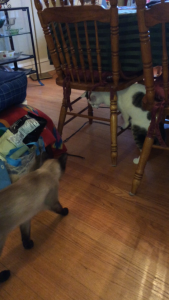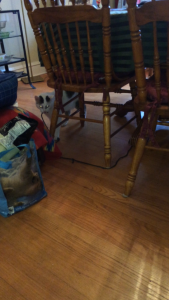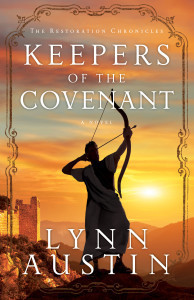Lynn Austin's Blog, page 19
May 4, 2015
Another Way to Tell a Story
 One of my favorite ways to nourish my creativity is to feed off the creative gifts of others. I do this by reading a good novel or going to a concert or to the art museum, seeing a play or going to a quilt show. Last Thursday my creativity had a veritable Thanksgiving Day feast when my husband and I and three family members went to see an original ballet entitled “It is Well.” It was performed by the Turning Pointe School of Dance in Holland, Michigan.
One of my favorite ways to nourish my creativity is to feed off the creative gifts of others. I do this by reading a good novel or going to a concert or to the art museum, seeing a play or going to a quilt show. Last Thursday my creativity had a veritable Thanksgiving Day feast when my husband and I and three family members went to see an original ballet entitled “It is Well.” It was performed by the Turning Pointe School of Dance in Holland, Michigan.
What impressed me even before the show started, was reading about the dance troupe itself. The goal of this ministry, founded in 1999, is to offer “Christ-centered, wholesome, artistically pleasing entertainment for the entire family.” To accomplish this, the non-profit organization trains dancers—nearly 400 of them in the Western Michigan area—by following the motto, “preparing the dancer in body and spirit to glorify God through artistic excellence.”
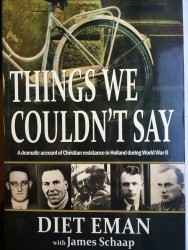 The original performance I attended that night was based on a book I had read several years ago entitled Things We Couldn’t Say by Diet Eman. The Dutch author tells the true story of how she and her fiancé, Hein Sietsma, along with a group of their young friends in the Netherlands, risked their lives to save Jewish families after the Nazi invasion in 1940. Diet was only nineteen years old, but her Christian faith and the deep commitment to God that she and Hein shared made them willing to serve Him no matter the cost.
The original performance I attended that night was based on a book I had read several years ago entitled Things We Couldn’t Say by Diet Eman. The Dutch author tells the true story of how she and her fiancé, Hein Sietsma, along with a group of their young friends in the Netherlands, risked their lives to save Jewish families after the Nazi invasion in 1940. Diet was only nineteen years old, but her Christian faith and the deep commitment to God that she and Hein shared made them willing to serve Him no matter the cost.
Their dangerous work with the Dutch resistance led to both of their arrests. Diet was imprisoned then sent to a concentration camp to await trial. In her book, she openly shares the spiritual struggles she experienced during that time and the anger and confusion she sometimes felt toward God. Yet her faith remained strong. Her fiancé Hein suffered imprisonment in multiple concentration camps during the course of the war, but his trust in God also endured. Diet was eventually released and continued working for the resistance until liberation. Hein died in Dachau Concentration Camp in Germany only a few months before the war ended.
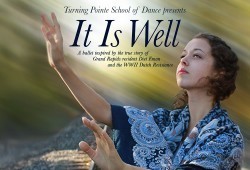 Now imagine this moving story set to music and interpreted by a team of creative, talented dancers. With only minimal narration, these artists conveyed all of the drama and emotional passion through movement and rhythm. We watched Diet and Hein meet and fall in love. We saw them working together to smuggle Jews out of danger. The darkness of the Nazi takeover was stunningly portrayed by a mass of dancers in simple black leotards who poured onto the stage and overshadowed the main characters, enveloping them in a gauzy black curtain. Another dancer beautifully symbolized the Holy Spirit’s presence in the concentration camp by lifting up Diet and her fellow inmates when they fell into despair and helping them raise their hands in prayer. As a writer, my medium of expression is words. This powerful experience of storytelling without words took my breath away.
Now imagine this moving story set to music and interpreted by a team of creative, talented dancers. With only minimal narration, these artists conveyed all of the drama and emotional passion through movement and rhythm. We watched Diet and Hein meet and fall in love. We saw them working together to smuggle Jews out of danger. The darkness of the Nazi takeover was stunningly portrayed by a mass of dancers in simple black leotards who poured onto the stage and overshadowed the main characters, enveloping them in a gauzy black curtain. Another dancer beautifully symbolized the Holy Spirit’s presence in the concentration camp by lifting up Diet and her fellow inmates when they fell into despair and helping them raise their hands in prayer. As a writer, my medium of expression is words. This powerful experience of storytelling without words took my breath away.
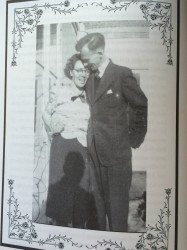 I came home with the creative jolt I was seeking—and more. The performance was a vivid reminder of how each of us can make a difference by obeying God and using our gifts. Diet and Hein served in one of history’s darkest hours by offering themselves to God—and every Jewish family they hid during the war survived. The dancers and choreographers developed and used their talents to bring Him glory, and the audience that night was deeply moved. We were reminded that we’re called to serve Him every day, whether it’s through writing or through dancing or by simply offering a cup of cold water in Jesus’ name.
I came home with the creative jolt I was seeking—and more. The performance was a vivid reminder of how each of us can make a difference by obeying God and using our gifts. Diet and Hein served in one of history’s darkest hours by offering themselves to God—and every Jewish family they hid during the war survived. The dancers and choreographers developed and used their talents to bring Him glory, and the audience that night was deeply moved. We were reminded that we’re called to serve Him every day, whether it’s through writing or through dancing or by simply offering a cup of cold water in Jesus’ name.
Hein wrote his last letter to Diet on a scavenged piece of paper and tossed it from his overcrowded railroad car on his way to Dachau. Miraculously, the letter was found and made its way to Diet after the war. Part of it reads:
“…even if we won’t see each other again on earth, we will never be sorry for what we did, that we took this stand.”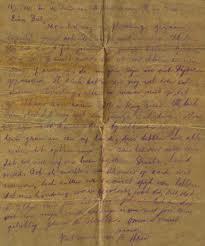
I wonder how God wants me and you to use our gifts today to share His great love with a hurting world?
April 20, 2015
Treasures
 What is one of your treasured possessions? An interviewer recently asked me that question, and at first I wondered if it was a trick. We’re not supposed to “store up for ourselves treasures on earth where moth and rust destroy, and where thieves break in and steal,” are we? I pondered the question for a while and came to the conclusion that I was overanalyzing it. Interviewers are probably just as tired of asking the same old questions as authors are of answering them—so they asked me a new one. And when I think about it, the answer provides a pretty good glimpse into someone’s heart, “For where your treasure is, there your heart will be also.”
What is one of your treasured possessions? An interviewer recently asked me that question, and at first I wondered if it was a trick. We’re not supposed to “store up for ourselves treasures on earth where moth and rust destroy, and where thieves break in and steal,” are we? I pondered the question for a while and came to the conclusion that I was overanalyzing it. Interviewers are probably just as tired of asking the same old questions as authors are of answering them—so they asked me a new one. And when I think about it, the answer provides a pretty good glimpse into someone’s heart, “For where your treasure is, there your heart will be also.”
 I’ve never been a “jewels and furs” kind of woman (to my husband’s great relief) nor do I treasure a closet full of expensive shoes or name-brand clothing. (Where would I ever wear them?) Yet most of us have things that we treasure for a variety of reasons—letters from a loved one, an heirloom trinket, family photographs, or our child’s plaster handprints—things that we would rescue if our house stood in the path of a forest fire. Their value doesn’t come from any monetary worth, but from what they mean to us. So here are three of my treasures:
I’ve never been a “jewels and furs” kind of woman (to my husband’s great relief) nor do I treasure a closet full of expensive shoes or name-brand clothing. (Where would I ever wear them?) Yet most of us have things that we treasure for a variety of reasons—letters from a loved one, an heirloom trinket, family photographs, or our child’s plaster handprints—things that we would rescue if our house stood in the path of a forest fire. Their value doesn’t come from any monetary worth, but from what they mean to us. So here are three of my treasures:
This is my great-great-grandmother’s “crying cup” from Germany. I remember drinking from it at my grandmother’s house when I was a child, and she told me she remembered drinking from it at her grandmother’s house. I featured it in my novel Eve’s Daughters, and my publisher even included a picture of it on the book cover. Grandma would let me drink from it whenever I was crying or upset, and my tears would “magically” go away. It worked every time. The cup reminds me that our sorrow is easier to bear when it’s shared with someone we love.
This is my great grandmother’s clock. I’ve seen enough of these clocks in antiques stores to know that it wouldn’t bring $Big Buck$ on “Antiques Roadshow.” When my great-grandfather bought it in 1896, it cost $5 in the Sears Roebuck catalogue. I treasure the clock because it was his gift to my great-grandmother on the day my grandmother was born. I picture great-grandma lying in bed, exhausted after giving birth, holding her new baby in her arms, and in walks her proud husband with a gift for her—a clock! (Doesn’t every new mother long for a clock?) At least she would know what time it was when she woke up in the middle of the night to feed the baby. And maybe he wanted to remind her—and me—how fleeting time is, and that we need to treasure the hours we spend with loved ones.
This is an ancient oil lamp more than 2,700 years old. The little clay bowl doesn’t look like much, but it sits on display in a place of prominence in my office. I bought it when I traveled to Israel and worked as a volunteer on an archaeological dig for a month to research my first book, Gods and Kings. The novel retells the biblical story of King Hezekiah, and I wanted a souvenir from his time period— 700 BC. I bought it in an antiquities shop in Jerusalem that is licensed to authenticate and sell artifacts. What amazes me is that the lamp has remained intact for so many centuries. Jerusalem was completely destroyed twice during those centuries—once by the Babylonians in 586 BC and again by the Romans in 70 AD. Yet this simple clay oil lamp managed to survive. It also survived my three active children, numerous curious pets, and at least three long-distance moves. The lamp sits where I can see it every day to remind myself of Jesus’ words: “You are the light of the world . . . let your light shine before men, that they may see your good deeds and praise your Father in heaven.”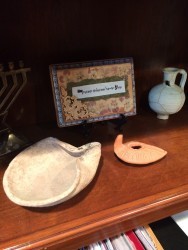
So . . . what is one of your treasured possessions? (It’s not a “trick” question.)
April 6, 2015
A Parable
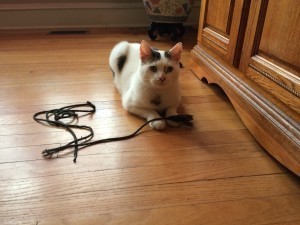 I just drove down to the post office to mail an old, worn-out pair of shoelaces to a cat! It had to be one of the weirdest packages I’ve ever sent. But Dexter, who is my “grand-cat,” was lost without those shoelaces and overjoyed to have them back. Before you think I’ve gone off the deep end, here’s the story.
I just drove down to the post office to mail an old, worn-out pair of shoelaces to a cat! It had to be one of the weirdest packages I’ve ever sent. But Dexter, who is my “grand-cat,” was lost without those shoelaces and overjoyed to have them back. Before you think I’ve gone off the deep end, here’s the story.
I’ve written about Dexter before—how he was a homeless, rescue cat that no one wanted. My daughter and her husband gave him a temporary foster home and “tamed” him to help their overcrowded, local animal shelter. When a permanent home was found and Dexter was suddenly snatched from our lives, we all realized how very much we’d grown to love him and his quirky personality. Dexter must have missed us too, because a week later, his new owners returned him to the shelter, saying things weren’t working out. My daughter and son-in-law welcomed him back, permanently adopting him into their home.
The old, tattered, half-unraveled shoelaces in this story came from my son-in-law’s hiking boots. He threw the laces into the garbage after replacing them with a new pair. Dexter retrieved them from the trash and made them his new favorite toy. Tied together, they make one long string that he entertains himself with for hours. He holds one end of the lace in his mouth and runs in circles around a chair or under the dining room table, wildly chasing the other end. Sometimes the shoelace gets so entangled in the chair rungs that his creation resembles a spider’s web. Unconcerned, he leaves it there when he’s finished playing. He has figured out how to unravel it again when he’s ready to renew the chase.
I kitty-sat for Dexter and his cat-brother, Leonidas, when my daughter and her husband went on vacation two weeks ago. Dexter had a grand time chasing his shoelace all over my house while he was here and winding it around my dining room chairs. And I have to admit that I enjoyed my morning snuggles with him when he would climb onto my lap to be hugged and petted, purring like a chainsaw, shedding white fur everywhere. But when we drove the cats back to Chicago, we accidentally left the shoelace behind. No other cord or string or shoelace could take the place of the worn-out, fraying one Dexter had grown to love. So I mailed it back to him. He retrieved it from the envelope himself.
 Now, I’m normally not one of those people who give human emotions to animals. But I can’t deny that Dexter’s shoelace makes him happy. And his story moves me because it’s such a perfect picture of redemption. My daughter and son-in-law took a wild, bedraggled cat into their home and redeemed him through their love and patience. He’s not the same animal that first arrived at the shelter. And Dexter’s “love” for a worn-out, discarded shoelace transformed it into a toy that was worthy of first-class postage.
Now, I’m normally not one of those people who give human emotions to animals. But I can’t deny that Dexter’s shoelace makes him happy. And his story moves me because it’s such a perfect picture of redemption. My daughter and son-in-law took a wild, bedraggled cat into their home and redeemed him through their love and patience. He’s not the same animal that first arrived at the shelter. And Dexter’s “love” for a worn-out, discarded shoelace transformed it into a toy that was worthy of first-class postage.
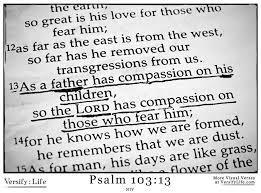 God redeems us because He is somehow able to look past our rough exterior and see a beloved child in need of grace. And the love He extends to us through His Son Jesus has the power to transform us and change our lives. Every time I look at Dexter and his shoelace I have to wonder how often I’ve turned away from difficult, unlovable people, judging them unredeemable, unworthy of my time or compassion or love. And I wonder what miracles might take place if I learned to see people the way this once-unlovable cat saw a piece of trash. Or the way our Heavenly Father sees me.
God redeems us because He is somehow able to look past our rough exterior and see a beloved child in need of grace. And the love He extends to us through His Son Jesus has the power to transform us and change our lives. Every time I look at Dexter and his shoelace I have to wonder how often I’ve turned away from difficult, unlovable people, judging them unredeemable, unworthy of my time or compassion or love. And I wonder what miracles might take place if I learned to see people the way this once-unlovable cat saw a piece of trash. Or the way our Heavenly Father sees me.
“As a father has compassion on his children, so the Lord has compassion on those who fear Him; for He knows how we are formed, He remembers that we are dust” (Psalm 103: 13-14).
March 16, 2015
Spring Fever
 Everyone I know has Spring Fever, including me. The sun is shining, the sky is blue, and the snow is melting at last. The steady drip of snowmelt from the eaves outside my office sounds like a drumbeat, summoning me to come outside and play. The season of new beginnings is here.
Everyone I know has Spring Fever, including me. The sun is shining, the sky is blue, and the snow is melting at last. The steady drip of snowmelt from the eaves outside my office sounds like a drumbeat, summoning me to come outside and play. The season of new beginnings is here.

Getting inspired at a Civil War Reenactment
And it’s a new beginning for my next writing project, too. My contract schedule has me handing in my manuscript in January then completing any changes my editor asks for in March. I’ve just finished that process and turned in all of my final changes and edits, so now I’m ready to start the process all over again with a new book.
But where will my ideas come from? How does the next story begin to form in my mind? Every author is different, but I begin by replenishing my supply of words. That means reading lots and lots of books. I choose authors who not only know how to tell a great story but also have an extraordinary love of language. I just finished two novels by one of my favorite writers, Rosamunde Pilcher, who can tell a gripping tale while painting word-pictures that are so vivid they can make me shiver: “Antony opened the front door, and the cold wind flowed in like a sluice of icy water.” Brr!
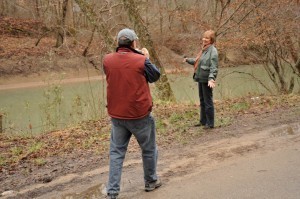
Me by the real life Wonderland Creek
At the same time, I start reading lots of non-fiction books about the historical time period or setting that I’ve chosen. This includes first-person accounts such as diaries or memoirs written by people who might have lived alongside my fictional characters. Whenever possible, I visit the setting for my new novel, taking photos and absorbing all the sights and sounds and smells, keeping track of them in a notebook for future use. I also love to ask people to tell me their love stories, or their God-stories, or their family’s story. (Warning: don’t ever tell me a story unless you’re not afraid to see it in one of my books!) I’m creating what I call “story soup,” tossing images and ideas and historical facts into a huge pot and letting it all simmer together in the back of my mind until I’m ready to start writing.
 One of the things I love to do while these ideas and images are simmering is to go outside in the gorgeous spring sunshine and sample God’s creative handiwork. I want the theme of His redemption to flow through all of my novels—how he takes what is broken and cold and dying and fills it with renewed life. And seeing the beauty of rebirth in nature as the snow melts and the new grass and spring leaves began to peek through,inspires me to tell of His goodness and grace all over again.
One of the things I love to do while these ideas and images are simmering is to go outside in the gorgeous spring sunshine and sample God’s creative handiwork. I want the theme of His redemption to flow through all of my novels—how he takes what is broken and cold and dying and fills it with renewed life. And seeing the beauty of rebirth in nature as the snow melts and the new grass and spring leaves began to peek through,inspires me to tell of His goodness and grace all over again.
 After the overwhelming destruction and judgment of the flood, God promised Noah—and us—that “As long as the earth endures, seedtime and harvest, cold and heat, summer and winter, day and night will never cease” (Genesis 8:22). We will always have seasons in life that feel like a long, dark, frigid winter—those times when life hits us in the face like “a sluice of icy water.” But He is the God of Springtime and new beginnings and second chances. He breathes life into the cold, dark corners of our hearts and we begin to find joy again. “Behold! I make all things new!” No wonder we have Spring Fever. Let’s go dance in the snow-puddles!
After the overwhelming destruction and judgment of the flood, God promised Noah—and us—that “As long as the earth endures, seedtime and harvest, cold and heat, summer and winter, day and night will never cease” (Genesis 8:22). We will always have seasons in life that feel like a long, dark, frigid winter—those times when life hits us in the face like “a sluice of icy water.” But He is the God of Springtime and new beginnings and second chances. He breathes life into the cold, dark corners of our hearts and we begin to find joy again. “Behold! I make all things new!” No wonder we have Spring Fever. Let’s go dance in the snow-puddles!
March 2, 2015
Sneak Peek…
I love previews of coming attractions and sneak peeks, don’t you? Even though the release of my next novel is months away (September of 2015), I just have to share a peek at the fabulous new cover with you.
On This Foundation will be the final book in my biblical fiction trilogy “The Restoration Chronicles,” in which I tried to bring to life the biblical books of Ezra and Nehemiah. The series tells about the Jewish survivors after the destruction of Jerusalem and how God made a way for them to return to the Promised Land from captivity in Babylon. The prophet Zechariah is the main character in the first book, Return to Me, which describes how the first returning exiles rebuilt God’s Temple in Jerusalem. The second book, Keepers of the Covenant, is the story of Ezra’s efforts to restore true worship and reignite his people’s passion for God. The final book, On This Foundation, will feature Nehemiah and his mission to rebuild the city wall around Jerusalem.
I thought the art department at Bethany House Publishers would have a very hard time coming up with a third cover as beautiful as the first two—but they did it! Not only is it striking, but they managed to hint at some of the drama and action in this novel.
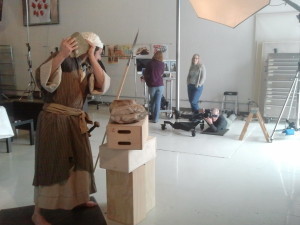 The designers always ask for my ideas and input into the cover design, and I thought it was important for the model who would portray Nehemiah to look Jewish. My daughter did some behind-the-scenes work and coaxed a Jewish friend of hers, Ben Shlimovitz, to come to the art studio and pose for the cover. Here are some outtakes from that photo shoot. I’m told that Ben was also a great help in getting the costuming right. Thank you Ben! Great job! I LOVE this cover!
The designers always ask for my ideas and input into the cover design, and I thought it was important for the model who would portray Nehemiah to look Jewish. My daughter did some behind-the-scenes work and coaxed a Jewish friend of hers, Ben Shlimovitz, to come to the art studio and pose for the cover. Here are some outtakes from that photo shoot. I’m told that Ben was also a great help in getting the costuming right. Thank you Ben! Great job! I LOVE this cover!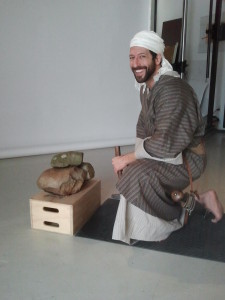
And now that I’ve generated some excitement about the book, I’m sorry to say that you won’t be able to read it until September. In the meantime, I’m taking an informal poll. Which of the three covers do you like best?
February 16, 2015
On the Research Trail
 Researching my books is one of my favorite parts of the writing process, and last week I got to do just that. My musician husband, Ken, was performing in New York City, so I flew there with him for a short, five-day trip. Since his concert was in the Brooklyn Navy Yard, we stayed in a hotel just a few blocks from the historic Brooklyn Bridge (completed in 1883 and still used by commuters to Manhattan Island). A nice stroll or drive across that famous bridge offers great views of the city skyline, the new World Trade tower, and even the statue of Liberty.
Researching my books is one of my favorite parts of the writing process, and last week I got to do just that. My musician husband, Ken, was performing in New York City, so I flew there with him for a short, five-day trip. Since his concert was in the Brooklyn Navy Yard, we stayed in a hotel just a few blocks from the historic Brooklyn Bridge (completed in 1883 and still used by commuters to Manhattan Island). A nice stroll or drive across that famous bridge offers great views of the city skyline, the new World Trade tower, and even the statue of Liberty.
I grew up in a small town in the Mid-Hudson Valley just north of New York City, so the trip also gave me a chance to visit my sister Peggy, who drove down to spend the day with me while Ken rehearsed. We decided to take the subway to Manhattan to visit the Tenement Museum on the Lower East Side and research the American immigrant experience for a future book. Wow! The museum turned out to be a treasure trove of information and experiences, and definitely worth a visit. (www.tenement.org)
The museum is housed in a tenement that was home to more than 7,000 people from over 20 nations between 1863 and 1935. The guided tours through the building and its recreated apartments and shops include a range of topics such as Hard Times, Sweatshop Workers, Shop Life, and Foods of the Lower East Side. Peggy and I had time for only one tour, so we’ll definitely be returning for a second visit.
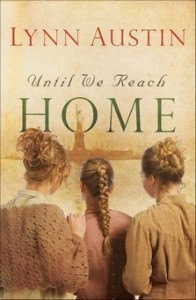 My sister had accompanied me on an earlier research trip to Ellis Island a few years ago when I was writing Until We Reach Home, and we were amazed by what our great-grandparents must have endured when they emigrated from Germany in the 1870s. We even found the record of their landing on Ellis Island. This time, the tour of the Tenement Museum gave us the next chapter of their story. The Lower East Side was known as “Little Germany” and this tenement building became a home away from home for new German immigrants, a place where they could eat familiar foods, talk with their fellow countrymen, and network for job opportunities.
My sister had accompanied me on an earlier research trip to Ellis Island a few years ago when I was writing Until We Reach Home, and we were amazed by what our great-grandparents must have endured when they emigrated from Germany in the 1870s. We even found the record of their landing on Ellis Island. This time, the tour of the Tenement Museum gave us the next chapter of their story. The Lower East Side was known as “Little Germany” and this tenement building became a home away from home for new German immigrants, a place where they could eat familiar foods, talk with their fellow countrymen, and network for job opportunities.
My great-grandparents must have been relieved to find a German-speaking community to help them adjust to their new country. They eventually moved to rural Pennsylvania where my great-grandfather farmed and worked as a carpenter. But for the immigrants who stayed in New York to live in the tenements and work in factories and sweatshops, life was depressingly difficult. The fact that so many stuck it out and made new lives for themselves and their families is a tribute to their hearty spirits and determination.
I still don’t know when or how my experiences at the Tenement Museum will make their way into a future book—but they will! In the meantime, I’d love to hear your ancestors’ stories of coming to America. You can go to my website, www.lynnaustin.org to share them with me. When my friend Maggie shared her Swedish great-grandmother’s experiences I used some of them in my novel Until We Reach Home. So who knows—your family’s story just might make it into one of my future books, too.
February 2, 2015
Recharging
 Don’t you hate it when the batteries go dead on devices you rely on like cell phones and laptops and tablets? But when we use them incessantly without taking time to plug them in, they eventually run down and stop working. After a year of hard work, I just completed another novel, and I have to admit that my creative batteries are dead. Totally dry. Used up. It’s time to take a break from writing (even if it’s a
Don’t you hate it when the batteries go dead on devices you rely on like cell phones and laptops and tablets? But when we use them incessantly without taking time to plug them in, they eventually run down and stop working. After a year of hard work, I just completed another novel, and I have to admit that my creative batteries are dead. Totally dry. Used up. It’s time to take a break from writing (even if it’s a
very short one) and recharge my batteries. How will I do it? I think everyone has to discover the best way they personally recharge, but here’s what works for me.
 Reading – Of course I’m always reading. But as I race toward the finish line on my manuscript, I put in such
Reading – Of course I’m always reading. But as I race toward the finish line on my manuscript, I put in such
long days at the computer that I don’t have time to read for pleasure. I feel like I’m all out of words! I’ve used them all up! It’s time to fill my head and heart with lots of new ones. I’m heading to the library and the bookstore for piles and piles of books so I can gorge myself on them. I’ll know I’ve reached my fill when words of my own start playing in my head again.
 Beauty – God’s creation is all around me if I take time to look, but when I’m under deadline, stopping to smell the roses just doesn’t happen. My world shrinks to two rooms—office and bedroom. I need to expand my world again and take time to notice the beautiful things all around me. Thankfully, I was blessed to enjoy my recharging session on gorgeous Sanibel Island in Florida last week. I enjoyed daily walks on shell-strewn beaches and bike rides through the island’s wildlife sanctuary. It doesn’t get much better than that! Now that I’m home, I’m noticing the snow-covered beauty of Michigan, and I’m ready to describe the beauty of God’s creation in my writing again.
Beauty – God’s creation is all around me if I take time to look, but when I’m under deadline, stopping to smell the roses just doesn’t happen. My world shrinks to two rooms—office and bedroom. I need to expand my world again and take time to notice the beautiful things all around me. Thankfully, I was blessed to enjoy my recharging session on gorgeous Sanibel Island in Florida last week. I enjoyed daily walks on shell-strewn beaches and bike rides through the island’s wildlife sanctuary. It doesn’t get much better than that! Now that I’m home, I’m noticing the snow-covered beauty of Michigan, and I’m ready to describe the beauty of God’s creation in my writing again.
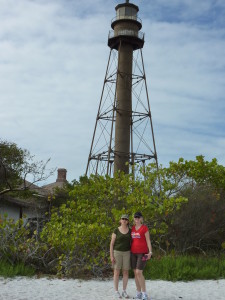 Friends – Writing is a very solitary job. Sometimes it seems like the only people I talk to are my imaginary characters. To recharge, I need to spend quality time relaxing with real people—especially my friends and family. My husband and I were fortunate to have two of our dearest friends joining us on Sanibel. With plenty of feasting and laughter and bike rides, I came home filled to overflowing, and ready to write about the relationships that are so important in all our lives.
Friends – Writing is a very solitary job. Sometimes it seems like the only people I talk to are my imaginary characters. To recharge, I need to spend quality time relaxing with real people—especially my friends and family. My husband and I were fortunate to have two of our dearest friends joining us on Sanibel. With plenty of feasting and laughter and bike rides, I came home filled to overflowing, and ready to write about the relationships that are so important in all our lives.
 Quiet Time With God – Even though I have a regular morning devotional time, it often feels rushed when I’m under deadline. When I’m recharging, it’s wonderful to be able to spend time just relaxing and reading the Bible, along with devotional books from my favorite Christian authors. It’s wonderful to take time to enjoy fellowship with God the way I’ve enjoyed being with my friends in Florida. And I know that the spiritual wisdom from my fellow Christian writers will give me new thoughts and ideas to write about when I’m ready to return to the computer.
Quiet Time With God – Even though I have a regular morning devotional time, it often feels rushed when I’m under deadline. When I’m recharging, it’s wonderful to be able to spend time just relaxing and reading the Bible, along with devotional books from my favorite Christian authors. It’s wonderful to take time to enjoy fellowship with God the way I’ve enjoyed being with my friends in Florida. And I know that the spiritual wisdom from my fellow Christian writers will give me new thoughts and ideas to write about when I’m ready to return to the computer.
Unlike the Energizer bunny, we can’t keep going . . . and going . . . and going . . . What recharges your batteries? How about scheduling a break, even a small one, to power-up for the work God has given each of us to do?
January 19, 2015
Parade of Lights
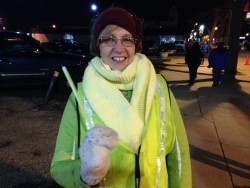 For our first Christmas in our new community, my husband and I decided to get involved by volunteering to be marshals for the annual Parade of Lights. Our job, we were told during orientation, was to make sure everyone remained behind the orange safety cones that lined the street so no one would get run-over by the parade floats and fire engines or trampled by the marching bands. It was especially important to watch over the small children and keep them out of the road. Sound easy enough?
For our first Christmas in our new community, my husband and I decided to get involved by volunteering to be marshals for the annual Parade of Lights. Our job, we were told during orientation, was to make sure everyone remained behind the orange safety cones that lined the street so no one would get run-over by the parade floats and fire engines or trampled by the marching bands. It was especially important to watch over the small children and keep them out of the road. Sound easy enough?
I thought so, too. What I didn’t realize was that the organizations sponsoring the floats would be tossing candy into the audience. And that dozens of foolish children would risk getting run over in order to get that candy. My simple job turned out to be not so simple.
 I started by smiling sweetly and asking the dear little cherubs to please step back. “We wouldn’t want to get squished now, would we?” By the time the last float rolled past it took every ounce of willpower to keep from screaming, “GET OUT OF THE ROAD! Do you want to die for a lousy piece of candy?”
I started by smiling sweetly and asking the dear little cherubs to please step back. “We wouldn’t want to get squished now, would we?” By the time the last float rolled past it took every ounce of willpower to keep from screaming, “GET OUT OF THE ROAD! Do you want to die for a lousy piece of candy?”
I confess that when my kids were small I was a helicopter mom, always hovering over them, worrying about all the terrible things that might happen if I didn’t remain vigilant. I realize now that it was because my writer’s imagination was always working overtime. I could easily visualize a multitude of plotlines for my children’s lives, and it was my job to make sure their stories ended happily-ever-after instead of in tragedy. It was exhausting. I envy mothers who lack this kind of imagination, never picturing their daughter’s prom date as a serial killer or their son’s class trip to the museum ending up on the evening news. My mothering—like my imagination—never went off-duty.
 So here I was at the Parade of Lights, dressed in a glowing green safety vest, responsible for keeping the citizens of my town safe behind the orange cones—for an entire city block. In the dark. With candy showering down from heaven on the giddy, over-excited children. I’m sure the floats were beautiful. I didn’t see them. I’m sure the twinkling lights seemed magical. I was too busy trying to remember what I’d learned during orientation about emergencies. Because I could see potential emergencies everywhere!
So here I was at the Parade of Lights, dressed in a glowing green safety vest, responsible for keeping the citizens of my town safe behind the orange cones—for an entire city block. In the dark. With candy showering down from heaven on the giddy, over-excited children. I’m sure the floats were beautiful. I didn’t see them. I’m sure the twinkling lights seemed magical. I was too busy trying to remember what I’d learned during orientation about emergencies. Because I could see potential emergencies everywhere!
Thankfully, none of the little darlings on “my” block got squished or trampled—although I may have come close to strangling one or two of them. Especially the kid who kept moving the safety cone into the street and insisting, “I am behind it!” But I was still imagining disasters as I lay in bed that night, trying to sleep, and I came to the conclusion that what I do for a living—writing novels—is a lot like being a safety marshal for the Parade of Lights. Here’s why.
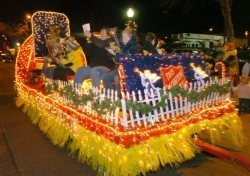 There are things in life that are very beautiful—like the parade floats. And things that can harm us—like the parade floats. The trick is in knowing where to stand. As I used to tell my children, the safest place to be is in the will of God. Temptation, like candy, promises something sweet, but reaching for it may cost us our lives. It’s my hope, my prayer, that the stories I write will not only entertain readers, but will help them see that the choices we make have consequences. When we fail to stay behind the “orange safety cones” that God has given us in His Word—or when we foolishly try to move them—we are in danger. And to do so for something that won’t bring long-lasting satisfaction is foolish indeed. As I dream up characters and plotlines for my novels, what I’m really doing is showing readers where to stand, and what might happen if we yield to temptation. And also how blessed our lives can be when we choose to walk with Christ, the Light of the World.
There are things in life that are very beautiful—like the parade floats. And things that can harm us—like the parade floats. The trick is in knowing where to stand. As I used to tell my children, the safest place to be is in the will of God. Temptation, like candy, promises something sweet, but reaching for it may cost us our lives. It’s my hope, my prayer, that the stories I write will not only entertain readers, but will help them see that the choices we make have consequences. When we fail to stay behind the “orange safety cones” that God has given us in His Word—or when we foolishly try to move them—we are in danger. And to do so for something that won’t bring long-lasting satisfaction is foolish indeed. As I dream up characters and plotlines for my novels, what I’m really doing is showing readers where to stand, and what might happen if we yield to temptation. And also how blessed our lives can be when we choose to walk with Christ, the Light of the World.
 As this New Year begins, please remember to stay behind the safety cones. “We wouldn’t want to get squished now, would we?” Don’t make me have to shout: “GET OUT OF THE ROAD! Do you want to die for a lousy piece of candy?” God has much better things planned for those who love Him. Enjoy the parade.
As this New Year begins, please remember to stay behind the safety cones. “We wouldn’t want to get squished now, would we?” Don’t make me have to shout: “GET OUT OF THE ROAD! Do you want to die for a lousy piece of candy?” God has much better things planned for those who love Him. Enjoy the parade.
January 5, 2015
A Year in Review
It’s popular this time of year for TV specials to review the past 12 months and remind us of all the events that occurred. I did something similar on January 1st and looked at my own year in review. Every morning during my quiet time I keep a journal, jotting down what I’ve been doing, what I’m praying for, and any insights that God shows me as I read my Bible. Sometimes it’s easy to miss the miraculous in the details of daily living, but as I re-read my journal for 2014, God’s hand became amazingly clear.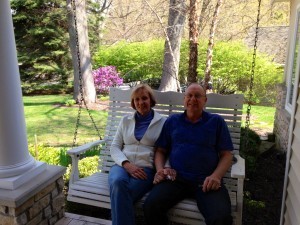
His answers to prayer, for instance. I began the year with many pleas for guidance as my husband prepared to retire from his job after 22 years. All the details of his retirement seemed overwhelming to me a year ago and occupied my prayers: selling our home, packing and purging and cleaning, moving to a new home in a new state, enduring financial changes, leaving friends and family behind. But here we are, settled-in and thriving, enjoying the changes, and thanking God for bringing us here. All that worry—for nothing!
 There were prayers for family members too, chief among them for our son to find a job after earning his PhD in May. It was a nail-biter and the waiting seemed endless, but in God’s perfect timing a job opened up for him at the beginning of the college year, one he is enjoying immensely. Looking back at answered prayers gives me faith to believe that God will answer my future prayers too, in the year ahead.
There were prayers for family members too, chief among them for our son to find a job after earning his PhD in May. It was a nail-biter and the waiting seemed endless, but in God’s perfect timing a job opened up for him at the beginning of the college year, one he is enjoying immensely. Looking back at answered prayers gives me faith to believe that God will answer my future prayers too, in the year ahead.
 On January 1, 2014, I wrote: “A brand new year. I can’t imagine what it will bring, but I’ll trust in God. I long to live intentionally, to enjoy life every day, and not simply mark time on a calendar or check off a to-do list.” Little did I know all the places I would go or how much I would need to trust Him! In March I traveled on a speaking tour to the Netherlands. When I returned I wrote, “God gave me strength and His words to speak. He is able to do more than we can ever ask or imagine.” I also spoke at Sandy Cove Retreat Center in Maryland, and went on a wonderful speaking tour in Germany in June. In my journal I recalled how terrified I used to be of public speaking and of flying. “I wonder how often my fear and doubt have caused me to miss the good things God planned for me,” I wrote. “If I had remained fearful of speaking and flying, I would have missed the blessings of serving Him in these amazing places.” I used to have so much fear—when all along, God held my life in His faithful hand.
On January 1, 2014, I wrote: “A brand new year. I can’t imagine what it will bring, but I’ll trust in God. I long to live intentionally, to enjoy life every day, and not simply mark time on a calendar or check off a to-do list.” Little did I know all the places I would go or how much I would need to trust Him! In March I traveled on a speaking tour to the Netherlands. When I returned I wrote, “God gave me strength and His words to speak. He is able to do more than we can ever ask or imagine.” I also spoke at Sandy Cove Retreat Center in Maryland, and went on a wonderful speaking tour in Germany in June. In my journal I recalled how terrified I used to be of public speaking and of flying. “I wonder how often my fear and doubt have caused me to miss the good things God planned for me,” I wrote. “If I had remained fearful of speaking and flying, I would have missed the blessings of serving Him in these amazing places.” I used to have so much fear—when all along, God held my life in His faithful hand.
 As 2014 drew to a close, I wrote on December 31: “This has been a year of so many changes and new beginnings! Lord, help me to change in the days ahead and become more and more like Jesus.” And when I think about it, maybe that’s what the trials and challenges we face are really all about—teaching us to trust our Savior and to become more and more like Him. As a New Year begins, I pray that God will help me replace worry and fear with faith and trust in Him.
As 2014 drew to a close, I wrote on December 31: “This has been a year of so many changes and new beginnings! Lord, help me to change in the days ahead and become more and more like Jesus.” And when I think about it, maybe that’s what the trials and challenges we face are really all about—teaching us to trust our Savior and to become more and more like Him. As a New Year begins, I pray that God will help me replace worry and fear with faith and trust in Him.
December 15, 2014
A Christmas Tradition
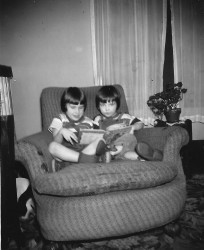
My sister, Bonnie, reading me a story
When I was growing up, my mother gave me the same, wonderful book for a Christmas gift every year. Mom was the librarian in the small village where we lived, and books were a fixture in our household for as long as I can remember. Mom loved to read aloud to my sisters and me, and classics such as Charlotte’s Web and Peter Pan were favorite bedtime stories. But the book Mom gave me every year for Christmas was Charles Dickens’ A Christmas Carol. She didn’t wrap it up and place it beneath the tree with the other gifts, but instead, read it aloud to us on Christmas Eve. As we grew older, my sisters and I would choose parts to read aloud along with Mom’s narration—Marley’s ghost or Tiny Tim or maybe Scrooge himself.

Our family Christmas tree
This annual tradition of reading together as a family helped me understand the true meaning of Christmas. The holiday has little to do with shopping or stressing or consuming, and everything to do with spending time together, sharing our love for each other and, in my family’s case, sharing our love for stories and words.

Our Manger scene on my beloved bookshelf
Dickens’ timeless book is a much-needed reminder in our busy days that we need to pause and reflect on our lives from time to time, as Ebenezer Scrooge was forced to do. We need to make sure we have our priorities straight; that the love of money isn’t consuming us; that we’ve made time for our families, and time to express our faith and love for God. And if we’ve gotten off track, change is possible even for the most hard-hearted of Scrooges. As the characters in A Christmas Carol taught me year after year, love is at the heart of Christmas. “God bless us, everyone!”


